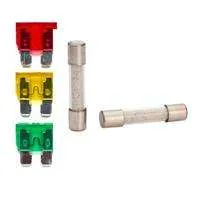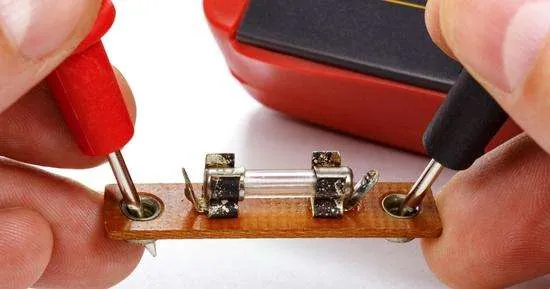A fuse is an electrical component to protect a circuit against overcurrent. A fuse has a thin alloy wire made of tin and lead that passes a controlled amount of current needed for your device.
When an electrical system suffers from overcurrent (excessive power supply), thin wire in the fuse installed in your devices melts due to increased temperatures, such as lead and tin melts at 183C.
Fuses are designed according to different circuits and environments. Still, their main role is to keep your appliances safe by interrupting the power supply when the current supply exceeds.
Table of Contents
ToggleHow does a fuse work?
When current passing in a circuit reaches a fuse, it enters the fuse from one metal end and travels through the thin wire to the other end and then to the circuit. The thickness of the wire in the fuse depends upon the model, use, and environment.
When the current in the circuit exceeds, the conductor’s temperature also increases, which makes the fuse wire melt and interrupt the circuit path to prevent your appliance from damaging (blowing).
Fuses are used in home circuits(outlets), electric motors, automotive appliances such as stabilizers, laptops, televisions, UPS, toasters, clothes iron, electric kettle, etc.
Commonly used fuses:
Two types of fuses are mostly used in household appliances and vehicles.
- Cartridge fuse
- Blade fuse
The cartridge fuse has a white or transparent cylinder shape body. A cartridge fuse has a thin lead or tin wire that melts down at high temperatures due to overcurrent and overloading in the circuit. Cartridge fuses are used in high voltage circuits such as industries, home distribution, and appliances such as motors, air conditioning, refrigerators, and pumps. Cartridge fuse works finely from months to a few years.
A blade fuse, also known as a spade or plug-in fuse, is made of a plastic body and prongs(pins) inserted into the socket and is mostly used in automobiles. Blade Fuses are used in low voltage circuits, come in six different sizes according to their application and last very long.
How to test a fuse with a multimeter?
To test a fuse, remove it from the device.
- Visually inspect if the thin conductor wire is fine.
- Set your multimeter to resistance (ohm) or continuity setting.
- Attach the multimeter probe’s pin at both metal ends of the fuse.
- If the fuse is fine, the multimeter will read very low resistance (around 0Ω).
- The fuse is damaged if the multimeter reads high resistance or OL.
Below we’ve discussed each step in detail:
Step 1: Remove the fuse and visually inspect
First, we’ve to turn off the power supply to remove the fuse from the installed device. You can also test the fuse while it’s plugged into a device until both metal ends are exposed, and multimeter probes can be attached for testing.
After removing the fuse, visually inspect it through the transparent cylindrical body. You’ll be able to see that the wire inside the fuse is broken. If the plastic body of the fuse is dark(smoke), it’s because the fuse is blown.
However, in some cases, you won’t be able to analyze the fuse due to the white plastic body visually. In this situation, we’ll use a multimeter to test a fuse.
Step 2: Multimeter setting for testing fuse
An OK fuse’s continuous path(wire) keeps supplying current. While in a blown fuse, conductor alloy wire is broken(melted), and the fuse has a discontinuity.
Insert the black probe in the COM-labeled port and the red probe in the VmAΩ port.
So we’ll set our multimeter to continuity or resistance mode because both these multimeter functions tell us about the ability of a conductor or circuit to pass current.
Adjust a low resistance range such as 200Ω.
Connect the metal pin of the multimeter probes to both metallic ends of the fuse.
Step 3: Evaluate the fuse with a multimeter reading
A fuse is designed to pass current fluently, so a fine fuse should have low resistance, such as 0 ohms.
While if your multimeter reads quite high, the resistance fuse wire is damaged and has poor current supplying capability.
However, if your multimeter reads OL while attached to both metal ends of a fuse, then there is no continuity in the fuse(broken path).
How to test a car fuse with a multimeter?
Around 40 Blade-type fuses are used in cars to protect several components from overcurrent and overheating. Fuses are located in the fuse boxes under the hood(engine) and near the dashboard(near the steering wheel).
These fuses protect your vehicle’s various components from overcurrent and damage by melting the fuse wire when the temperature in the circuit increases then a maximum range.
Fuses used in cars last for several years (10 or above) because they are used in low-voltage circuits, such as a car that functions with a 12V battery.
-
Locate the fuse and remove it for testing.
First, you must identify a malfunctioning component and test that specific fuse.
You can locate fuses in the fuse panel(fuse box) and under the hood (near the battery). Check the diagram to locate the specific fuse you want to test. Unplug both terminals(blades or pins) from the fuse socket.
Fuses used in cars don’t have a transparent body, so you can’t visually decide whether the fuse wire is blown. However, a blown fuse will have burn marks, a dark spot, or a melted body.
-
Adjust your Multimeter
Same as any other fuse, fuses used in cars are also tested for continuity to determine fuse health.
Set your multimeter to continuity o resistance at a lower range, such as 200 ohms.
Connect the multimeter probes on both terminals(pins) of the fuse. A fuse should have minimum resistance to be a good conductor.
The fuse is OK if the multimeter reads between 0-5 ohms. However, the different fuse can have different resistance ranges depending upon their manufacture.
If the multimeter reads too high resistance, the fuse is damaged (degraded), which is why the current face difficulty passing through it.
While if the multimeter reads OL, it means that the fuse is completely blown.
Frequently Asked Questions
How to test a fuse without a multimeter?
You can test a fuse without a multimeter by placing it in a battery-based circuit. Take a small battery and bulb, and make a circuit by attaching the battery to the bulb.
Place the fuse in between the circuit. On completing the circuit, if the bulb glows, it indicates that the circuit is complete and your fuse is fine(can pass current).
How to test a 30 amp fuse?
30 amp fuse is available in cylindrical and blade shapes. Inspect the metal caps(terminals) o the fuses for corrosion and degradation, affecting the fuse conductivity.
If you have a multimeter, check the resistance in the fuse’s metal ends(terminals). A fine fuse should have around 0 resistance, and OL means the fuse wire is broken(no continuity).
How to test a ceramic fuse without a multimeter?
A ceramic fuse can’t be visually examined due to a colored body(usually white or black) made of ceramic material. Make a small circuit by attaching a bulb to a battery. Place your fuse between the battery and bulb to become part of the circuit (path for current).
If the fuse is fine, the bulb should glow when you complete the circuit. The fuse is an excellent passing current through its thin metal wire.
However, if the bulb doesn’t glow, the fuse has no continuity(broken wire).
How to check fuses without removing them?
If you want to test a fuse without removing it from the circuit, you should be able to locate(reach) and check it with your tool.
Take a multimeter, set it to resistance, and place the red and black probes at both ends of the fuse. Don’t let the probes touch anything other than fuse ends. A fine fuse should have 0-3 ohm resistance.
How do test fuses and relays with a multimeter?
Locate the fuse relay box and identify the relay and fuse you want to test. Check resistance in the coil terminals of the relay. A good relay should have 40-120 ohm resistance. Also, test continuity in the NO(normally open) terminal while connected to power and NC(normally closed) terminals without current.
In the same way, test resistance in the fuse metal terminals. The multimeter will read OL (open loop) if the fuse is blown.
Conclusion:
Testing a fuse is easy and essential to keep your appliances and vehicles working smoothly. A multimeter quickly tests all fuses(Cartridge, blade, ceramics). Locate the fuse; if inaccessible, unplug it from the circuit and test resistance continuity between both terminals of the fuse.
If you still find anything complicated, ask us in the comments below.
Related Guides:






